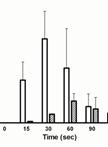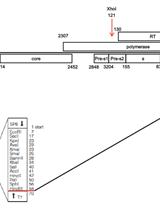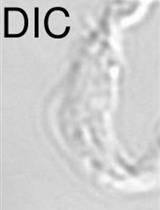- EN - English
- CN - 中文
Determination of Mutation Frequency During Viral DNA Replication
病毒DNA复制过程中的突变频率测定
发布: 2014年03月20日第4卷第6期 DOI: 10.21769/BioProtoc.1076 浏览次数: 9418
评审: Anonymous reviewer(s)
Abstract
This protocol is a simple method for evaluating mutation frequency during African swine fever virus (ASFV) replication, although it could be used also for other DNA viruses (poxvirus, herpesvirus, mimivirus, etc) with minor modifications. In the original Carrascosa et al. (1982), the protocol was carried out with two cloned viruses, BA71Vc (a purified clone from BA71V wild type strain) and vΔpolX (lacking the reparative polymerase, pol X, gene), and two different cell types that can be infected by ASFV, Vero cells and swine macrophages. To facilitate the sequence comparison, a genome fragment containing the B646L gene was amplified by PCR and blunt-end cloned. This gene codes for the major capsid protein (p72) and multiple sequences can be found in the database, so the mutations found could be compared with natural gene variations. The cloned fragment can be either sequenced directly from bacteria colonies or from miniprep purified DNA.
Materials and Reagents
- Virus supernatants (previously titrated)
- XL-1 Blue competent bacterial cells (Stratagene, catalog Number: 200249 )
- Dulbecco modified Eagle medium (DMEM) (Sigma-Aldrich, catalog number: D5523 )
- Fetal Bovine Serum (Sigma-Aldrich, catalog number: F7524 )
- Vero Cells (ATCC, catalog number: CCL-81 TM)
- Alveolar swine macrophages (Carrascosa et al., 1982)
- Swine serum (obtained during the macrophages purification)
- Kapa HiFi polymerase (Kapa Biosystems, catalog number: KK2101 )
Note: This polymerase kit includes buffer and dNTPs.
- Primer B646L forward (Sigma-Aldrich)
5’ATGGCATCAGGAGGAGCTTTTTGTCTTATT
- Primer B646L reverse (Sigma-Aldrich)
5’TTAGGTACTGTAACGCAGCACAGCTGAACCG
- CloneJet PCR Cloning Kit (Thermo Fisher Scientific, catalog number: K1231 )
Note: This kit includes the pJET plasmid, DNA ligase and reaction buffer.
- Agarose for DNA electrophoresis (Lonza, SeaKem® LE Agarose, catalog number: 50000 )
- TAE buffer (Sambrook and Russell, 2001)
- TE buffer (pH 8.0) (Sambrook and Russell, 2001)
- 5x Agarose Gel loading dye (QIAGEN, catalog number: 239901 )
- QIAquick gel extraction kit (QIAGEN, catalog number: 28704 )
- LB-agar plates (Sambrook and Russell, 2001)
- Ampicillin (Sigma-Aldrich, catalog number: A0166 )
- Double-distillated or Milli-Q water
Equipment
- MW24 plates (BD Biosciences, Falcon®, catalog number: 353047 )
- 1.5 ml Eppendorf tubes
- Cell culture incubator
- Refrigerated benchtop centrifuge (e.g. Hettich 200 R)
- Thermal-cycler for PCR
- Electrophoresis system for agarose gels and UV-documentation device to visualize the DNA bands
- Waterbath
Software
- Diverse bioinformatics software (e.g., Geneious or CLC Genomics Workbench) (optional)
- MS Excel, Prism Graph Pad or SPSS (optional)
Procedure
文章信息
版权信息
© 2014 The Authors; exclusive licensee Bio-protocol LLC.
如何引用
Redrejo-Rodríguez, M., Rodríguez, J. M., Suárez, C. and Salas, M. L. (2014). Determination of Mutation Frequency During Viral DNA Replication. Bio-protocol 4(6): e1076. DOI: 10.21769/BioProtoc.1076.
分类
微生物学 > 微生物遗传学 > DNA > DNA 复制
分子生物学 > DNA > 诱/突变
分子生物学 > DNA > PCR
您对这篇实验方法有问题吗?
在此处发布您的问题,我们将邀请本文作者来回答。同时,我们会将您的问题发布到Bio-protocol Exchange,以便寻求社区成员的帮助。
Share
Bluesky
X
Copy link















